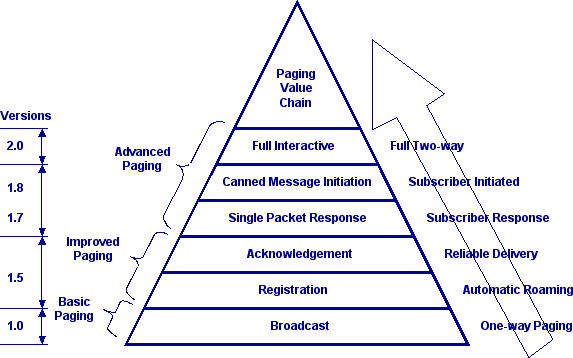| A BRIEF DESCRIPTION OF TWO-WAY PAGING |
If the various versions of two-way paging are a little confusing to you—you are not alone. Maybe the illustration below will help clear up what the different versions are.
We all know what one-way paging is—the pager is just a selective-call radio receiver. If you add a tiny transmitter inside of the pager then you are moving into the realm of two-way paging, since the pager now has the ability to talk back. The early ones were called "one-and-a-half-way pagers" (1.5) since they could only send limited responses back to the infrastructure. Even though limited, the simple responses of "I am here" and "I got it" allowed the paging industry to offer automatic roaming and assured message delivery. This was a great step forward. You will never miss a message because the system keeps trying until your pager says "I got it" and automatic roaming to other cities (and even other countries) is possible because the pager always says "I am here" as soon as you get off of an airplane and turn it on. Other features were added later with various names and numbers, until we finally got to "full two-way" (2.0) pagers—which are basically pagers that can send and receive alphanumeric text messages—usually with a small keyboard. We will be seeing many more variations such as wireless-telemetry devices, wireless e-mailers, and wireless-enabled PDAs. (Personal Digital Assistants.) I hope this brief description helps clarify what the different version of two-way paging are—not everyone who reads this is an engineer.

1.5-way
paging
Refers to guaranteed message receipt or advanced messaging, ensuring subscribers
receive messages sent when they are out of range, but users cannot send text
pages. "One and a half way" also allows for automatic roaming.
Assured
Delivery
A one-and-a-half-way device is capable of providing guaranteed message delivery
by acknowledging receipt of a message, on a per message basis. Even when the
user is out of range, or when the pager is turned off, messages are stored and
then forwarded to the pager when it's back on or within range.
Automatic
Roaming
With automatic registration, the one-and-a-half-way device can register its
geographic location on the network. This allows for transmission of alphanumeric
text messages more efficiently and economically than traditional one-way-broadcast
paging networks, where the pager location is unknown.
1.7-way
paging
A paging service that offers more than guaranteed messaging but not as much
as full two-way paging. The subscriber has limited response messaging, such
as canned messages, rather than the ability to create responses.
| END OF TWO-WAY VERSION SECTION |
| Home Page | Directory | Consulting | Newsletters | Free Subscription | Products | Reference | Glossary | Send e-mail |